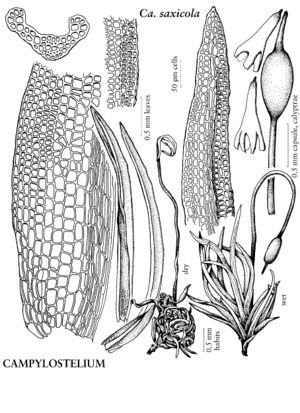Campylostelium saxicola
Bryol. Europ. 2: 27. 1846,.
Plants glossy. Leaves 2–3 mm, often circinately curled when dry, margins entire, erect; apices acute, subcucullate. Seta 5–7 mm, twisted below the capsule and often flexuous when dry, often recurved when wet. Capsule 1–1.2 mm, smooth or slightly wrinkled when dry; operculum red proximally, 0.5–0.7 mm; peristome teeth red. Calyptra 0.7 mm, mostly shallowly lobed proximally. Spores 8–10 µm.
Phenology: Capsules mature Oct–May.
Habitat: Forests or openings on acidic sandstone boulders and cliffs, and sandstone rock shelters
Elevation: moderate elevations (400-1300 m)
Distribution

P.E.I., Que., Ala., Ark., D.C., Ind., Ky., Mass., N.H., N.J., N.Y., N.C., Ohio, S.C., Tenn., Va., Wash., Europe.
Discussion
Campylostelium saxicola is a tiny moss with glossy, crisped, or sometimes circinate leaves; it grows on shaded boulders in forests over most of its range but in rock shelters in the southern portion. Campylostelium saxicola is wide-spread in the flora area but infrequently collected due to its inconspicuous nature. Its small delicate stature, smooth calyptra, and usually flexuous-curved seta distinguish it from Ptychomitrium.
Selected References
None.
